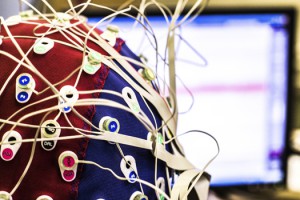 There is something very futuristic, and perhaps scary, about the idea of nonverbally transferring one person’s thoughts to another person, especially for the purpose of controlling or influencing a person’s actions and behaviors. Maybe that’s why telepathy and mind control are favorite topics of many science fiction movies. However, there are times when direct, nonverbal transfer of thoughts would be advantageous, for example when communicating complex concepts or feelings that are difficult to convey. Direct transfer also would circumvent the need to translate information from one language to another. For these reasons, scientists are currently developing technologies to allow such thought transfers. A recent PLOS ONE article describes a simple brain-to-brain interface in humans and shows how this interface can be used to capture a thought generated by one person and communicate that information directly to the brain of a second person and elicit a physical response (1).
There is something very futuristic, and perhaps scary, about the idea of nonverbally transferring one person’s thoughts to another person, especially for the purpose of controlling or influencing a person’s actions and behaviors. Maybe that’s why telepathy and mind control are favorite topics of many science fiction movies. However, there are times when direct, nonverbal transfer of thoughts would be advantageous, for example when communicating complex concepts or feelings that are difficult to convey. Direct transfer also would circumvent the need to translate information from one language to another. For these reasons, scientists are currently developing technologies to allow such thought transfers. A recent PLOS ONE article describes a simple brain-to-brain interface in humans and shows how this interface can be used to capture a thought generated by one person and communicate that information directly to the brain of a second person and elicit a physical response (1).
This noninvasive interface consisted of two people (a sender and a receiver), two computers, the Internet, an electrode cap and a transcranial magnetic stimulation (TMS) machine. Using this interface, the sender’s thought is captured by electroencephalography (EEG), and the resulting EEG signal is sent via standard hypertext transfer protocol (http) to another computer that delivers transcranial magnetic stimulation to the receiver’s brain. Preliminary experiments must be performed with the receiver to determine the optimal location and intensity of TMS to elicit the desired physical response.
To demonstrate the effectiveness of their interface, the researchers designed a simple computer game in which a city was under attack by pirates; the player defended the city by pressing a touchpad to fire a cannon that destroyed incoming enemy rockets. If the cannon was fired before the rocket reached the city, the city was saved. Simple enough for one person. However, the researchers separated the game between three pairs of players (3 senders and 3 receivers): The sender saw the computer screen and knew when a rocket was fired at the city but did not have access to the touchpad to fire the cannon. The touchpad was controlled by the receiver who could not see the computer screen and had no way of knowing when rockets were fired at the city. The sender and receiver were located in separate buildings approximately 1 mile apart and had no other way of communicating. Only through communication between the sender and receiver would the cannon be fired and the city saved.
Each sender was trained so that when he saw a rocket flying toward the city, he imagined his right hand pressing the touchpad to fire the cannon. This motor imagery was captured as an EEG signal. At the same time, a cursor on his screen activated the “Fire” button (even though he hadn’t moved) so that he got immediate feedback that the rocket had been fired. The EEG signal was then sent to the second computer, which delivered a TMS pulse to the region of the receiver’s brain that controls the extensor carpi radialis muscle, causing his hand to move. This movement was sufficient to activate the touchpad and fire the cannon. Thus, when the sender imagined moving his hand to fire the cannon, a magnetic pulse stimulated the receiver’s brain, causing him to fire the cannon.
Timing of the cannon fire was important, and this fact tested the real-time nature of data transmission. The total transmission time was a mere 650ms and included approximately 10ms to transmit the information over the Internet, 1.4ms to activate the TMS machine, 4.0ms to generate the TMS pulse and 627ms for the receiver’s physical response. Plenty of time to destroy the rocket before it reaches the city.
To rule out any false positives, the researchers designed controls in which the sender still responded to enemy rockets on the computer screen and the TMS machine still delivered a pulse of the same intensity but the position of the magnetic coil was changed so that the TMS pulse was redirected and did not cause hand movements. There were no false positives, and only one instance where the receiver moved his hand without TMS.
The authors of this proof-of-concept study emphasize several important aspects of this research. First, they show that technology exists to create a brain-to-brain interface through which two people can communicate simple thoughts and actions. Unlike invasive forms of brain interfaces, such as those that require electrodes to be surgically implanted in the senders’ and receivers’ brains, this interface is noninvasive. Finally, Rao et al. hope that these experiments will hasten discussions between scientists, ethicists and regulatory agencies about the ethical and societal implications of these types of interfaces, especially because future capabilities and technologies may permit the transmission of much more complex information.
For the foreseeable future, be assured that telepathy and mind control are still limited to science fiction movies. There is no need for a tinfoil hat.
Reference
- Rao, R.P.N. et al. (2014) A Direct Brain-to-Brain Interface in Humans. PLOS ONE DOI: 10.1371/journal.pone.0111332
